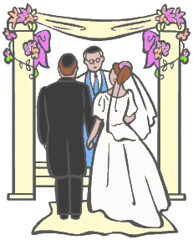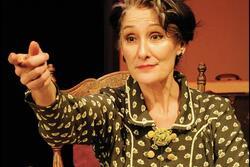The American Jewess: Jewish Weddings in 1898

by, Rebecca Hoenig Friedman, cross-posted on Jewess
It's June. Wedding season is officially upon us, and with it, a return to our feature on The American Jewess after a brief hiatus.
What better topic to explore than the state of the Jewish wedding in turn-of-the-century America. If the piece "Going Under the Chupah" written by An Immigrant, is to be believed, the chuppah had gone out of fashion in Jewish-American weddings. "A large number of Jews and Jewesses living in America have never witnessed a genuine Jewish wedding ceremony," s/he writes:
"The 'chupah,' which plays such an important part in a matrimonial venture, is an unknown quantity to American-born Jews. The Jewish Ghetto in New York, however, adheres strictly to the old time Jewish wedding ceremonial and festivities.
Uniting people in wedlock according to the old Jewish customs and with the pomp and display which indicates Oriental origin is one of the industries which always flourishes in the New York Ghetto ..."
Once again the themes of assimilation and class differences rear their heads, as they have in several of these posts.
The anonymous Immigrant tells TAJ's readers, presumably a middle-to-upper-class bunch, about the traditional Jewish wedding, transplanted from Eastern Europe, as it's practiced in the Jewish ghetto on the East Side (read: Lower East Side). Interestingly, what she describes sounds much like the traditional Jewish weddings being held these days, which presumably are more common among non-immigrants and well-to-do people than they were back in 1898. And actually, if you've ever been to a Persian wedding, it sounds pretty much exactly the same (i.e. guests showing up two hours late, off-the-hook dancing, and only getting down to eating dinner at 11 o'clock).
So without further ado, here is the immigrant's description of a traditional Lower East Side Jewish wedding in 1898:
"Such a thing as a strictly quiet wedding, with no witnesses except the immediate members of the family, is almost unknown in the Jewish quarter. When the wedding contract has been signed and the schatchen's work completed, there is usually an 'engagement party,' at which the parents of the bride-elect make public announcement of the engagement of their daughter, and break a glass in the presence of their guests to indicate that the contract is not fragile, like the works of man, and cannot be broken like them.
"All those who come to the engagement party are usually asked to the wedding ceremony, and receive invitations which are printed on fancy embossed cards in English and "Yiddish," and sometimes in German also. These invitations are worded nearly like the ordinary wedding invitation, but in every instance a line follows the address where the ceremony will take place, which tells the 'bride's residence.'
"The people who are the least blessed with worldly goods have the ceremony performed at the home of the bride; those who have more hire the synagogue for the occasion, and those who are of the highest circle in the Ghetto have the ceremony performed in the synagogue and hire a hall for the wedding dance and dinner. But the largest number of weddings take place in the halls which are arranged for the purpose.
"'When people are very swell,' said the proprietor of one of these halls, 'they hire the hat box, and their guests don't have to pay for hat checks.'
"The invitations usually give 5 or 6 o'clock as the hour for the ceremony, and at the time named the bride and bridegroom arrive with their respective kinspeople. The bride is attired in white satin and long veil, and has many flowers, and the man in evening clothes. They take stations in different rooms, and as the guests arrive the ceremony of Kabolath-ponim or presenting takes place. This lasts until the guests have all arrived, generally an hour or two later than the time named on the invitation cards —and then, if it is a large company, the young people have a dance or two. This over, the bridegroom takes his place under the chupah, or canopy, in the large hall, and there awaits the coming of his bride, who is brought to him by her father. The chupah, or canopy, has been an important feature in the Jewish wedding ceremonial ever since there has been any record, and one of the East Side rabbis said that a verse of the Bible refers plainly to the 'joyous voice of the bridegroom from under the chupah.'
"The canopy is made of velvet and may be of any color, although it is usually purple or deep red, and is trimmed with gold lace and has the star of David embroidered in gold in one end. Under this canopy, which symbolizes the future home of the family, the bride is taken by her parents and the rabbi performs the marriage ceremony. When the couple have taken wine from the same glass to show that they will be partners in joy, and the ring has been placed on the bride's finger, a glass is again broken, because at no joyous occasion should the Jew forget that the glory of the Jewish nation is broken, and the broken glass reminds him of that. It also reminds the young people that sooner or later all must return to dust, and, even like the beautiful glass, be shattered and destroyed.
"The ceremony over, everybody congratulates his neighbor as well as the bridal couple, and then, under the leadership of the chief actors, the whole party goes to the dining-room, where luncheon is served. Since early in the morning the kitchen has been in charge of a Kochfrau, under whose direction a luncheon as well as a supper, which is served later in the evening, has been prepared. The luncheon lasts only a short time, and then the dancing begins and lasts until supper is served at about 11 o'clock."





